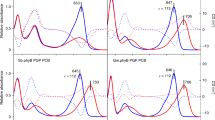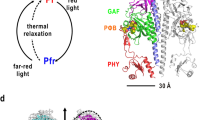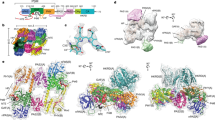Abstract
The phytochrome photoreceptor family directs plant gene expression by switching between biologically inactive and active conformers in response to the sequential absorption of red and far-red photons1,2. Several intermediates that act late in the phytochrome signalling pathway have been identified, but fewer have been identified that act early in the pathway3,4. We have cloned a nuclear basic helix–loop–helix protein, PIF3, which can bind to non-photoactive carboxy-terminal fragments of phytochromes A and B and functions in phytochrome signalling in vivo5. Here we show that full-length photoactive phytochrome B binds PIF3 in vitro only upon light-induced conversion to its active form, and that photoconversion back to its inactive form causes dissociation from PIF3. We conclude that photosensory signalling by phytochrome B involves light-induced, conformer-specific recognition of the putative transcriptional regulator PIF3, providing a potential mechanism for direct photoregulation of gene expression.
This is a preview of subscription content, access via your institution
Access options
Subscribe to this journal
Receive 51 print issues and online access
$199.00 per year
only $3.90 per issue
Buy this article
- Purchase on Springer Link
- Instant access to full article PDF
Prices may be subject to local taxes which are calculated during checkout




Similar content being viewed by others
References
Kendrick, R. E. & Kronenberg, G. H. M. Photomorphogenesis in Plants 2nd edn (Kluwer Academic, Dordrecht, Netherlands, (1994).
Quail, P. H. et al. Phytochromes: Photosensory perception and signal transduction. Science 268, 675–680 (1995).
Quail, P. H. The phytochrome family: Dissection of functional roles and signalling pathways among family members. Phil. Trans. R. Soc. Lond. B 353, 1399–1403 (1998).
Deng, X.-W. & Quail, P. H. Signaling in light-controled development. Semin. Cell Dev. Biol.(in the press).
Ni, M., Tepperman, J. M. & Quail, P. H. PIF3, a phytochrome-interacting factor necessary for normal photoinduced signal transduction, is a novel basic helix–loop–helix protein. Cell 95, 657–667 (1998).
Mathews, S. & Sharrock, R. A. Phytochrome gene diversity. Plant Cell Environ. 20, 666–671 (1997).
Quail, P. H. An emerging molecular map of the phytochromes. Plant Cell Environ. 20, 657–665 (1997).
Terzaghi, W. B. & Cashmore, A. R. Light-regulated transcription. Annu. Rev. Plant Physiol. Plant Mol. Biol. 46, 445–474 (1995).
Tobin, E. & Kehoe, D. M. Phytochrome regulated gene expression. Semin. Cell Biol. 5, 335–346 (1994).
Chory, J. et al. From seed germination to flowering, light controls plant development via the pigment phytochrome. Proc. Natl Acad. Sci. USA 93, 12066–12071 (1996).
Wei, N. & Deng, X.-W. The role of the COP/DET/FUS genes in light control of Arabidopsis seedling development. Plant Physiol. 112, 871–878 (1996).
Wagner, D. & Quail, P. H. Mutational analysis of phytochrome B identifies a small COOH-terminal-domain region critical for regulatory activity. Proc. Natl Acad. Sci. USA 92, 8596–8600 (1995).
Xu, Y., Parks, B. M., Short, T. W. & Quail, P. H. Missense mutations define a restricted segment in the COOH-terminal domain of phytochrome A critical to its regulatory activity. Plant Cell 7, 1433–1443 (1995).
Sakamoto, K. & Nagatani, A. Nuclear localization activity of phytochrome B. Plant J. 10, 859–868 (1996).
Yeh, K.-C. & Lagarias, J. C. Eukaryotic phytochromes: light-regulated serine/threonine protein kinases with histidine kinase ancestry. Proc. Natl Acad. Sci. USA 95, 13976–13981 (1998).
Somers, D. E., Sharrock, R. A., Tepperman, J. M. & Quail, P. H. The hy3 long hypocotyl mutant of Arabidopsis is deficient in phytochrome B. Plant Cell 3, 1263–1274 (1991).
Scheer, H. in Techniques in Photomorphogenesis (eds Smith, H. & Holmes, M. G.) 227–256 (Academic, London, New York, (1984).
Acknowledgements
We thank C. Fairchild for the gift of phycocyanobilin; C. Fairchild, M. Hudson, E.Huq, J. Martinez and E. Monte for critical reading of the manuscript; lab members for discussion and support; and R. Wells for help with the manuscript. This work was supported by grants from the DOG and USDA.
Author information
Authors and Affiliations
Corresponding author
Rights and permissions
About this article
Cite this article
Ni, M., Tepperman, J. & Quail, P. Binding of phytochrome B to its nuclear signalling partner PIF3 is reversibly induced by light. Nature 400, 781–784 (1999). https://doi.org/10.1038/23500
Received:
Accepted:
Issue Date:
DOI: https://doi.org/10.1038/23500
This article is cited by
-
Understanding the mechanism of red light-induced melatonin biosynthesis facilitates the engineering of melatonin-enriched tomatoes
Nature Communications (2023)
-
Genome-Wide Identification, In Silico Characterization of AtCOP1-Targeting Regulatory Proteins Network and their Expression Profiling in The COP1 Downregulated Arabidopsis thaliana
Journal of Plant Growth Regulation (2023)
-
The involvement of the N-terminal PHR domain of Arabidopsis cryptochromes in mediating light signaling
aBIOTECH (2021)
-
Optogenetic approaches for understanding homeostatic and degenerative processes in Drosophila
Cellular and Molecular Life Sciences (2021)
-
Characteristics and Functions of PePIF3, a Gene Related to Circadian Rhythm in “Nanlin 895” Poplar
Plant Molecular Biology Reporter (2020)
Comments
By submitting a comment you agree to abide by our Terms and Community Guidelines. If you find something abusive or that does not comply with our terms or guidelines please flag it as inappropriate.



